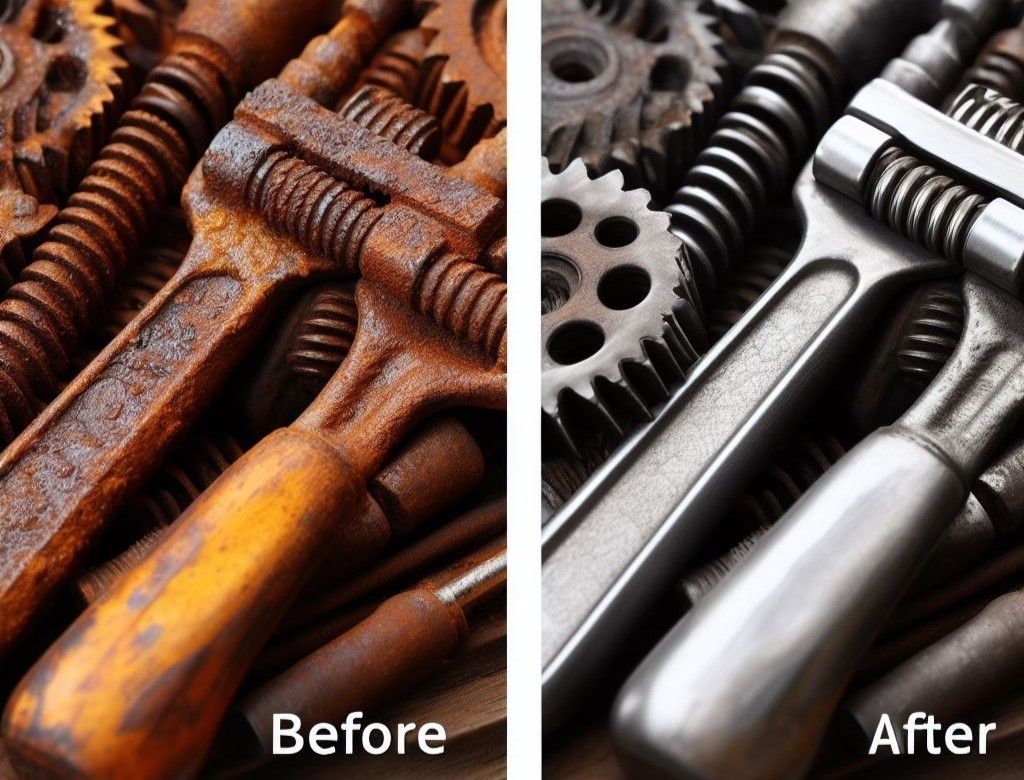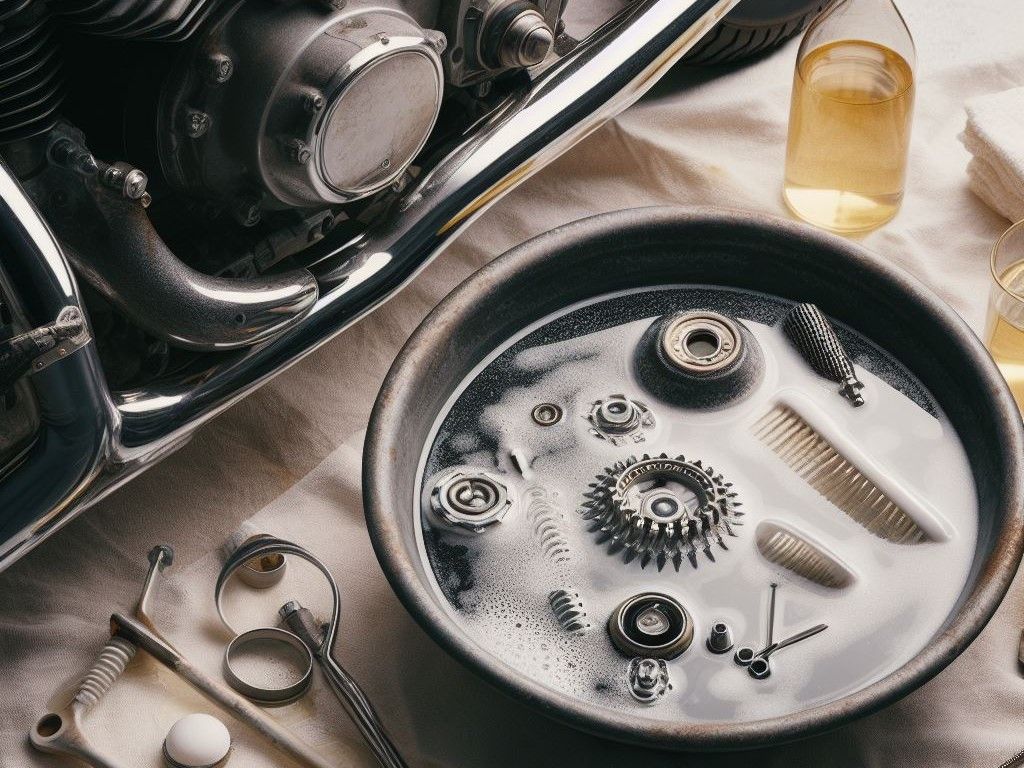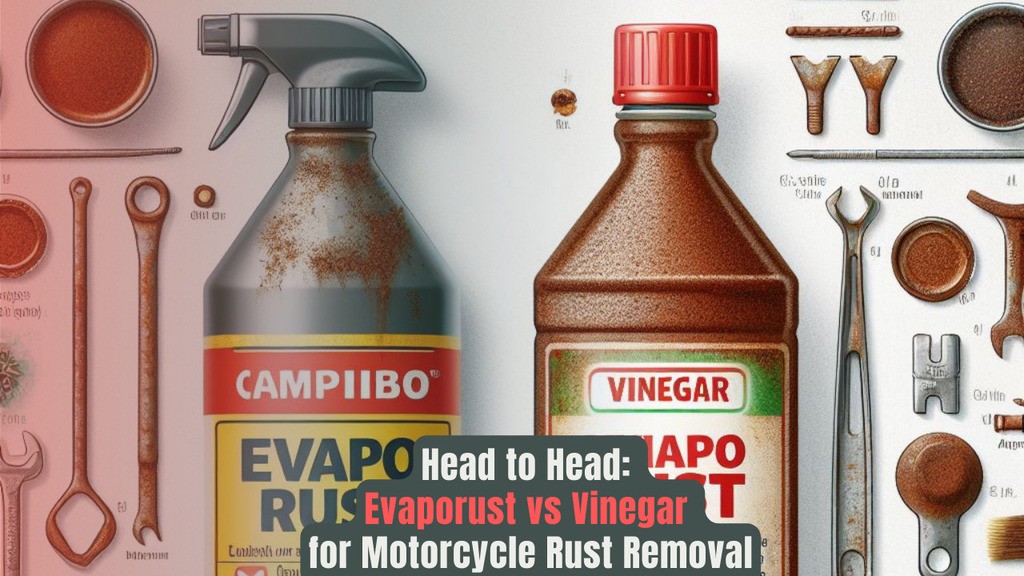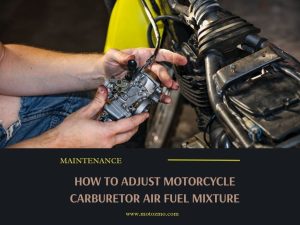Some of the links in this post are affiliate links, meaning we may get a small commission when you purchase through our links, at no extra cost to you. It helps us covering the expenses of keeping this site free for you. Thank you for your support!
You lift the seat on your vintage Honda and see rust swirling inside the tank. Makes your heart sink! Or maybe you’re rebuilding that old Yamaha you found in a barn.
Either way, the rust has to go. Trick is doing it without messing with the vintage paint job you’ve worked so hard to preserve.
That’s where products like Evaporust and good old white vinegar come in. They promise to dissolve the rust while leaving your paint or patina intact.
But which one really works better for motorcycle applications? And which is going to be easier on your wallet?
I’m going to share my hands-on experience testing Evaporust vs vinegar side by side.
I’ll look at how well they tackle rusty parts like gas tanks, frames, and fenders. I’ll also clue you in on costs and potential gotchas to watch out for.

Buying Options

Buying Options
| Evaporust | White Vinegar | |
|---|---|---|
| Rust Removal Effectiveness | Very effective on all types, especially embedded rust. Fast results. | Good for light-medium rust. Slower on heavy pitting. |
| Residue Left Behind | Some greasy film residue to clean. | No residue, parts dry completely. |
| Effect on Paint/Surfaces | Safe but may require extra cleaning. Slight residue. | Completely safe, no cleaning required after rinsing. |
| Performance in Hard to Reach Areas | Excellent, but surface tension limits access. | Very low viscosity allows deep penetration. |
| Pitted Rust Removal | Removes completely, often within 1-2 soakings. | Gradual, may require multiple soakings. |
| Temperature Effect | Works well at room temperature. | Performance significantly increased in warm conditions. |
| Typical Cost for Small Parts | $30+ for a gallon. Reusable. | $10+ for a gallon. Reusable. |
| Cost for Large Parts/Projects | Expensive for large jobs due to high initial price. | Inexpensive, as low as $10-20 for major projects. |
| Recommendation for Motorcycle Tanks | Highly recommended for best performance. | Recommended as a low-cost solution. |
NOTE: While both products work, Evaporust provides better overall rust removal, especially for embedded or heavy rust. White vinegar is good for low-rust areas and budget projects.
Evaporust vs Vinegar: How Do They Work?
Let’s get into the nitty gritty of how each one does the job.
Evaporust works through a chemical reaction between its proprietary formula and rust.
Basically, it uses ions to break the bond between rust particles and the metal surface. This allows the rust to dissolve away from your parts. No muss, no fuss.
As for white vinegar, it’s basically acetic acid which creates an environment that rust can’t survive in. The low pH of the vinegar dissolves the rust into Calcium Acetate.
Adding salt to vinegar raises the conductivity and allows the acetic acid to penetrate rust better. It works especially well on those pesky flat surfaces.
I tried both methods on some heavy rust I found at the bottom of my saddlebags. After a few hours in Evaporust, the rust completely dissolved.
The vinegar concoction made the rust looser but still clinging on in spots. Neither did any damage to the paint either, which was my main concern.
Of course, your mileage may vary based on how severe the rust is. For light surface stuff, vinegar would probably do the trick on its own.
But if you’ve got rust so bad it looks like the metal is dissolving, you might need the heavy artillery of Evaporust.
Either way, both of these methods are definitely gentler on your paint than wire brushing or sanding!
SEE MORE: The Ultimate Guide to How to Remove Rust from Motorcycle Chain
The Pros and Cons
Let’s dive into some of the pros and cons to help you decide which rust busting tactic might be best for your project.
When it comes to ease of use, Evaporust has a slight edge. You just toss your parts in the liquid and let it do its thing without much fussing around.
Compared to vinegar which needs agitation and scrubbing as it works to dissolve the rust.
However, one downside I noticed with Evaporust is that it can leave a bit of a gummy residue behind if it splashes around inside tight spaces. This wouldn’t be ideal if you’re cleaning out a gas tank.
With vinegar, there’s no mess to clean up afterwards since it rinses away completely with water. No sticky surprise down the line!
Warning: Vinegar will eat into the metal if you leave it for a long time. It also corrodes aluminum and other soft metals. Evaporust is safe for all metals.
Cost is also something to think about. A jug of white vinegar is peanuts compared to buying pre-made Evaporust.
And vinegar works out to be way more economical if you need large volumes to submerge parts like frames or cases. On the other hand, a small Evaporust container might be enough for simple jobs.
So in summary – Evaporust is very hands-off but can residue issues and higher costs. White vinegar can staining but it rinses totally clean with no lingering mess.
You’ll likely use a bit more elbow grease too. Think about your specific project and pick the attributes that matter most!
Evaporust vs White Vinegar: Side-by-Side Test
It was time to really see how Evaporust stacks up against white vinegar for tackling motorcycle rust.
To give each method a fair shot, I set up a side-by-side comparison using some rusty parts I had laying around.
Test Setup for Rusty Motorcycle Parts
For this Evaporust vs vinegar smackdown, I scrounged up a couple rearsets off an old Honda CB550.
The pedal and gear pegs were coated in surface rust but should be representative of what you find on tanks, fenders, and other exterior parts.
I submerged one set in a container filled with Evaporust. For the other, it was a diluted white vinegar solution with some salt tossed in per the usual recipe.
To monitor progress, I’d take the pieces in and out every 4 hours to inspect how much rust was loosening up.
I made sure to agitate the vinegar parts a bit each time to mimic scrubbing as it worked. Temperature was around 65°F/18°C in my garage.
After a day of soaking, I was eager to see which common rust remover would reign supreme in the evaporust vs vinegar grudge match! Keep reading to find out which method earned bragging rights.
The Results Are IN!
After giving the rust removal methods a day to work their magic, it was time to see how the parts looked.
When I removed the rearsets from their Evaporust vs vinegar baths, I was actually pretty surprised by what I found!
The Evaporust had done a solid job on the pedal. Most of the rust was now flaky and brushed right off. Some stubborn spots remained but not too bad overall.
Similar story for the gear peg – the rust took on a dull, powdery appearance and wiped away easily.
The white vinegar parts weren’t still fully clean. Just to be thorough, I agitated the vinegar parts a bit more under running water.
Sure enough, more rust streaks came away with each rinse to reveal smooth metal beneath.
Both methods worked well enough, but Evaporust eradicated rust more fully with less effort on my part.

Effectiveness: Which One Zaps Rust Best?
The Evaporust handled surface rust pretty well overall. If the rust coating was thin and flaky, it loosened up within a hours of soaking. More stubborn rust took longer but still brushed off eventually.
Vinegar seemed to struggle a bit more was with thicker, pitted rust. The kind that’s eaten away into the metal more deeply. It took days for this heavier rust to start coming loose.
Evaporust ripped through surface rust just as speedily as vinegar. But it really shone when tackling embedded rust pockets.
Where vinegar was still working after days, Evaporust completely eradicated deep rust craters within a couple days.
Scrubbing with an old toothbrush helped speed things along, but the chemical bath did heavy lifting on its own too. The rust just dissolved away, leaving a flush metal surface behind.
SEE MORE: Best Chain Cleaner for Motorcycle: Ultimate Grime Busters
Aftermath: What’s Left Behind?
Now that the rust removal battle was won, I took a closer look at what kind of aftermath each method left on the treated parts. This is important to consider depending on where you plan to use Evaporust vs white vinegar.
With the Evaporust-soaked rearsets, I noticed a slight waxy, greasy film leftover on areas it had splashed.
Not a huge amount, but a noticeable smear none the less. Working it off required some extra elbow grease and degreaser.
This residue could potentially cause issues if Evaporust gets inside places you don’t want mystery goop residing.
Like the inside of gas tanks or hard to clean areas. That greasy streak took a while to fully wash away too.
On the other hand, the white vinegar parts were pristine! Not a trace of residue at all after a simple rinse. The rust had fully dissolved away, leaving smooth, dry metal.
No doubt this makes vinegar the safer choice if you don’t want to risk any unwanted remnants.
Especially for jobs where you need to fully flush out the metal afterward without oily streaks. Evaporust leaves a slightly messier aftermath to deal with.
Evapo-Rust ER012 Super Safe – 128 oz., Non Toxic Rust Remover for Auto Parts, Hardware, Antiques

FEATURES WE LIKED
- Effortlessly removes rust from automotive parts
- Non-toxic and water-based solution
- Contains no harmful acids, solvents, bases, odors or fumes
Buying Options
Iberia All Natural Distilled White Vinegar, 1 Gallon – 5% Acidity (Pack of 2)

FEATURES WE LIKED
- Good for cleaning
- Consistent, safe, and made in the USA
- All Natural – 1 Gallon – 5% Acidity
Buying Options
How Evaporust and White Vinegar Perform at a Deeper Level
In my Evaporust vs vinegar test, it was clear that Evaporust had a real edge when it came to deeply embedded rust.
But I wanted to do a deeper dive on just how well each product conquers those stubborn rust pockets.
Handling Pitted Rust
After the main test, I set aside some parts with severe pitting for round two. Taking a closer look under bright lights really showed off gnarly rust divots eaten down to bare metal.
When I tried Evaporust again, the results were fast and dramatic. Within hours, a toothbrush easily scrubbed away what looked like solid rust blobs.
But they had actually dissolved completely, revealing smooth pit floors. By the next day inspection, all deep rust etching had vanished.
It really drove home how the chemical penetrates rust all the way to its roots.
Over time, it purifies the metal entirely rather than just lifting flakes off the surface. This is especially valuable for repairable antiques with sentimental value.
But submerging these heavily corroded samples back into fresh vinegar, I was still noticing only gradual progress after multiple days of soaking.
The pits were shallowing out but stubborn rust stuck at the bottom.
Removing Rust from Hard-to-Reach Areas
When restoring old bikes, being able to remove rust from fiddly nooks and crannies is crucial. So I wanted to see how Evaporust and white vinegar compared at tackling hard to reach rust.
To test this, I gathered some small pieces with rounded edges and tight internal pockets of rust. Things like old brake caliper mounting tabs and buckled frame spars. Really tricky terrain for any rust remover.
Plunging these smashed up pieces into Evaporust, I found its liquid consistency helped sink right into tight spots.
However, due to surface tension, it didn’t seem to fully displace trapped air inside deep crevices.
This meant during soaking, a lot of rust lingered out of reach of the chemical reaction. Even with agitation, it wouldn’t budge come time to scrub. Frustrating for such fiddly components.
Opting for vinegar next made an incredible difference. As a thinner liquid, it totally displaced air and wicked deep into each crevice overnight.
Come morning, a simple rinse removed piles of rust from chambers I didn’t think possible.
This showed me white vinegar’s low viscosity is a real asset for intricate, indented rust landscapes. It creeps into impossible places like no other solution I’ve used. A total winner for precision rust repair projects.

Does Temperature Affect the Performance?
One factor that could potentially sway the Evaporust vs vinegar battle is how temperature affects each treatment’s performance.
So, for the final round, I set up another test to see how these rust removal methods reacted to warmer conditions.
I took some mildly rusted parts and split them between new Evaporust and vinegar solutions indoors.
Then I set up a second soak outdoors where daytime temps had been hitting the 80s. Both were given 6 hours of treatment.
Checking in a few hours rust dissolving noticeably faster in the warm fluids, as you’d expect with chemical reactions. However, the real surprise was how much vinegar dominated in the heat!
While Evaporust kept chugging along, the heated white vinegar outright pulverized rust.
Within a few hours, all traces of corrosion were gone from those hot soaks. It was clear the hot climate really supercharged vinegar’s acetic acid properties.
While both work fine at room temperature, warmer conditions give white vinegar’s rust-stripping abilities an extra boost.
Definitely the solution to use when temps rise and heavy duty rust removal is needed. Heat is its gasoline!
SEE MORE: Best Motorcycle Engine Oil for Hot Weather
Evaporust and Vinegar: Are They Paint Safe?
One major concern when busting rust is preserving any original paint or plating that remains. So let’s discuss how well Evaporust and white vinegar back up their claims of being paint-safe.
How Do They Treat Paint?
One major concern when busting rust is preserving any original paint or plating that remains. As advertised, I can confirm neither caused any visible damage even to delicate old finishes after prolonged soaks.
Both Evaporust and white vinegar kept original colors intact as rust was dissolved.
However, I did notice one subtle difference in how each treated surfaces. With Evaporust, the lubricating residue left a faint greasy sheen on paint that had to be wiped away.
Vinegar on the other hand left pristine paint that looked and felt completely untouched. No need for additional cleaning or protection of surfaces.
Its total lack of residue is ideal for preserving patinas down to the microscopic level.
Avoid Over Application
While Evaporust and vinegar will not directly damage paint when used correctly, over application could potentially lead to unintended consequences on delicate surfaces. Knowing when to stop is key.
With extended soaking times, I noticed Evaporust’s residue buildup increased on test parts. Excessive splashing around could leave unsightly smears on original colors if not cleaned promptly. Best to limit submersion periods.
Vinegar was more forgiving, but repeated brushing in one spot began to ever so slightly dull paint sheen over days of use. Rinsing thoroughly between applications erased any effect. Moderation is smart here as well.
For both products, less is generally more when it comes to preserving pristine paintwork. Clear away residue often with Evaporust to avoid building up grime. And don’t over-agitate vinegar solutions on one small area for too long.
If the urge to scrub lingers, it may be best to remove trim or break parts down further before rust busting decorated pieces. Better to introduce the least risk of mishap near fragile old finishes.
The Cost Breakdown of Evaporust and Vinegar
When it comes to DIY rust removal, upfront costs matter. So let’s crunch some numbers on typical Evaporust vs white vinegar prices to treat anything from small parts to full motorcycle tanks.
A standard 1-gallon bottle of Evaporust goes for slightly higher than $30. This would treat many small rusted bolts, fittings or minor parts. But for say, a 20L tank, you’d spend $100+ on multiple bottles.
Contrast that to a simple gallon of distilled white vinegar at around $10. It would take several gallons max to submerge even a large tank. So, around $30 or $40 treatment for the same task.
However, you can reuse Evaporust. Let the used chemical sit for a while, waiting for the sediment to settle down. The pour it (without agitating the sediment) into the gallon or where you want to keep it.
Since it does not have a shelf life, it will not expire if kept properly sealed. You need to discard it only when it’s color turn into almost black from its usual light yellow.
You can also reuse vinegar the same way until it completely loses its effectiveness.
For bigger rust removal jobs like frames, fenders or cases, the savings multiply quickly in vinegar’s favor. A few buckets would tackle any project for $20-30 at most.

Buying Options

Buying Options
Putting Evaporust and Vinegar to Best Use Recommendations
After thoroughly testing both Evaporust and white vinegar side by side, I’ve come up with some recommendations on preferred use cases and application tips for each rust busting product:
- For light surface rust on small parts, either will work great. Evaporust may be a tad quicker if agitation isn’t possible.
- Evaporust also reigns supreme for heavier pitted jobs thanks to superior penetration. Some scrubbing aids the process.
- Intricate areas are where vinegar really shines too, creeping easily into confined spaces.
- If rust is embedded all around a part, like say a tank interior, nothing cleans more completely than an acid bath!
- Always use proper ventilation with both Evaporust and vinegar and work in a well lit area for safety.
- Dilute vinegar as instructed for best results.




